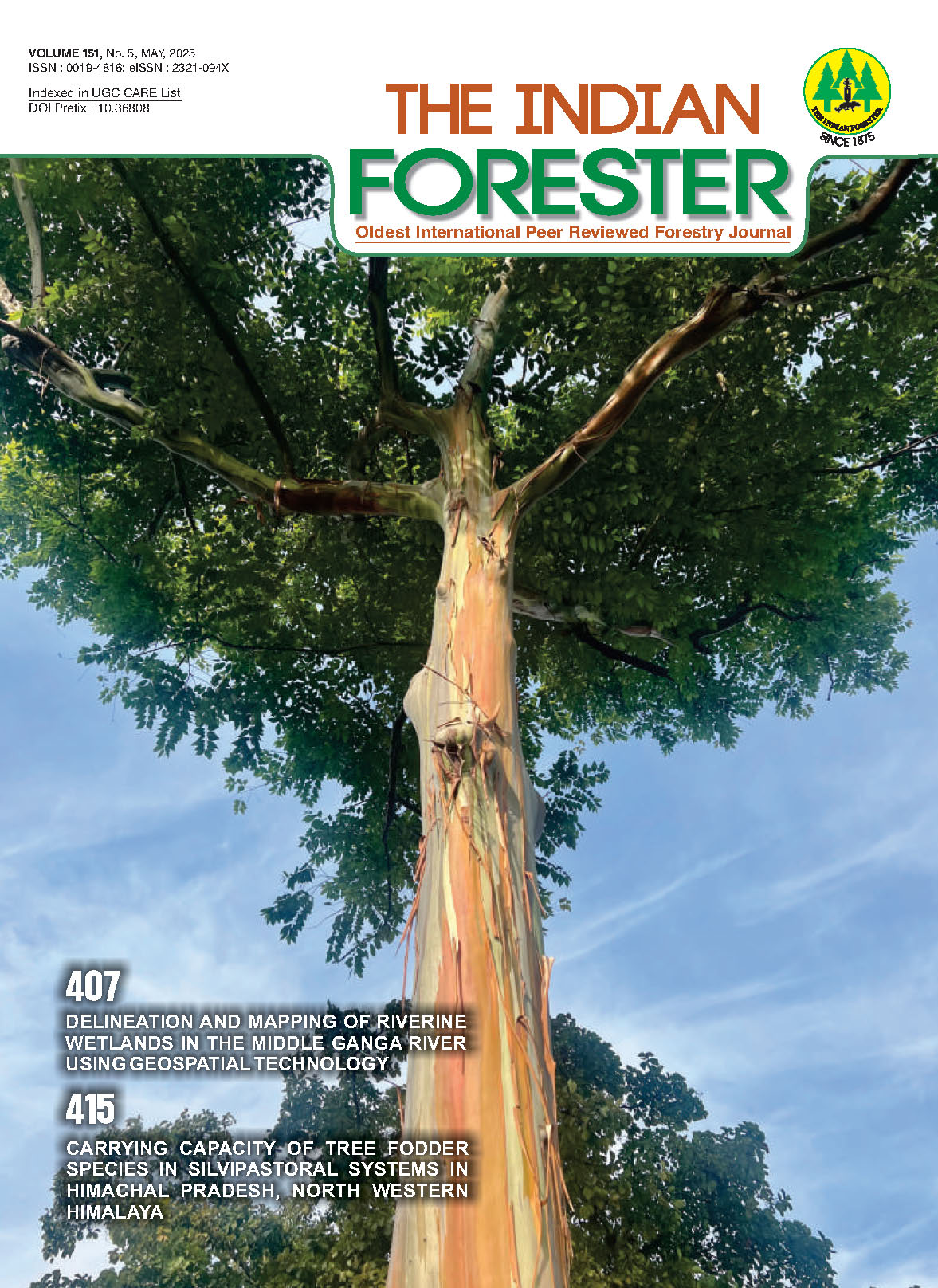Exploration of Lichenized fungi in Tea Gardens of Assam
DOI:
https://doi.org/10.36808/if/2025/v151i5/170667Keywords:
Assam, Biodiversity, Crustose lichen, Tea Garden.Abstract
Lichens are capable of growing on any substratum both natural and manmade. Tea plants serve as one such important substratum that supports growth of lichen. An attempt was made to understand the distribution of lichen diversity growing over nine tea gardens of Assam spatially distributed over three districts of Assam viz. Dibrugarh, Tinsukia and Sonitpur. A total of 71 species of lichen under 26 genera and 15 families were identified. It was dominated by crustose lichen (82%) followed by foliose and leprose lichen with 17% and 1% respectively. The family Graphidaceae comprising seven genera and 26 species emerged as the most dominant showing its luxuriant growth followed by Caliciaceae and Pyrenulaceae with 11 and nine species respectively. Among the genera, the tea gardens were mainly dominated by Graphis (15 species) followed by Pyrenula with nine species. The species, Dirinaria applanata, Graphis scripta and Trypethelium eluteriae were commonly found in all the districts. Of the three districts, highest number of lichen species was reported from Sonitpur with 59 species, while Tinsukia and Dibrugarh exhibited 18 and 7 species individually. The reason for a smaller number of lichen species in the other two districts is due to inadequate exploration of the regions for lichenology.
References
Aptroot A. (2012). A world key to the species of Anthracothecium and Pyrenula, The Lichenologist, 44(1): 5-53. DOI: https://doi.org/10.1017/S0024282911000624
Awasthi D.D. (1991). A key to the Microlichens of India, Nepal, Sri Lanka, Bibliotheca Lichenologica, 40: 1-340. DOI: https://doi.org/10.2307/1222799
Awasthi D.D. (2007). A compendium of the Macrolichens from st India, Nepal, Sri Lanka.1 ed. Bishen Singh Mahendra Pal Singh, Dehra Dun, India.
Gogoi R., Devi D., Nayaka S. and Yasmin F. (2022). A checklist of lichens of Assam, India. Asian Journal of Conservation Biology, 11(1): 49-65. https://doi.org/10.53562/ajcb.73760 DOI: https://doi.org/10.53562/ajcb.73760
Gupta P., Sinha G.P. and Solanki C.M. (2013.) Epiphytic lichens in tea gardens of Assam, India, Indian Journal of Forestry, 36(2): 279-284. https://doi.org/10.54207/bsmps1000-2013-503872 DOI: https://doi.org/10.54207/bsmps1000-2013-503872
Gupta P. and Sinha G.P. (2018). Lichen flora of Assam. Indian Journal of Forestry. Add. Ser. V. Bishen Singh Mahendra Pal Singh, Dehra Dun, India.
Islary P., Biswas S., Nayaka S., Joseph S., Upreti D.K., Basumatary D. and Daimari R. (2022b). New distributional records of lichenized fungi for India from Assam. Vegetos. https://doi.org/10.1007/s42535-022-00523-y DOI: https://doi.org/10.1007/s42535-022-00523-y
Islary P., Daimari R., Biswas S., Nayaka S., Joseph S. and Dwimary S. (2022a). An enumeration of lichen diversity from Ultapni Forest Range of Kokrajhar district, Assam with Ocellularia calvescens and Rhabdodiscussubcavatus, two new records in India. Studies in fungi 7, 5. https://doi.org/10.48130/SIF-2022-0005 DOI: https://doi.org/10.48130/SIF-2022-0005
Islary P., Thakur M., Kumar V., Biswas S., Mishra G.K., Nayaka S., Joseph S. and Daimari R. (2024). New distributional records of lichenized fungi for India from Assam. Vegetos. https://doi.org/10.1007/s42535-024-01036-6 DOI: https://doi.org/10.1007/s42535-024-01036-6
Lücking R., Archer A.W. and Aptroot A. (2009). A world-wide key to the genus Graphis (Ostropales: Graphidaceae), The Lichenologist, 41(4): 363-452.https://doi.org/10.1017/S0024282909008305 DOI: https://doi.org/10.1017/S0024282909008305
Makhija U. and Adawadkar B. (2007). Trans-septate species of Acanthothecis and Fissurina from India, The Lichenologist, 39(2): 165-185. https://doi.org/10.1017/S0024282907004756 DOI: https://doi.org/10.1017/S0024282907004756
Orange A., James P.W. and White F.J. (2010). Microchemical methods for the identification of Lichens, 2nd edition. London: British Lichen Society.
Soundararajan S., Shanmugam P., Nagarajan N., Palanisamy D. and Ponnusamy P. (2019). In-vitro study on screening antimicrobial and antioxidant potential of Ramalina fastigiata. Journal of Drug Delivery and Therapeutics, 9(1): 216-219. https://.org/10.22270/jddt.v9i1.2217 DOI: https://doi.org/10.22270/jddt.v9i1.2217
Upreti D.K. (1994). Notes on corticolous and saxicolous species of Porina from India, with Porina subhibernica sp. nov., The Bryologist, 97(1): 73-79.https://doi.org/10.2307/3243353 DOI: https://doi.org/10.2307/3243353
Wijayawardene N.N., Hyde K.D., Al-Ani L.K.T., Tedersoo L. et al. (2020). Outline of Fungi and fungus-like taxa. Mycosphere, 11(1):1060-1456. http://hdl.handle.net/1854/LU-8660838 DOI: https://doi.org/10.5943/mycosphere/11/1/8
Downloads
Downloads
Published
How to Cite
Issue
Section
License
Unless otherwise stated, copyright or similar rights in all materials presented on the site, including graphical images, are owned by Indian Forester.





